SMA eCharger: Charge your journey with the power of the sun
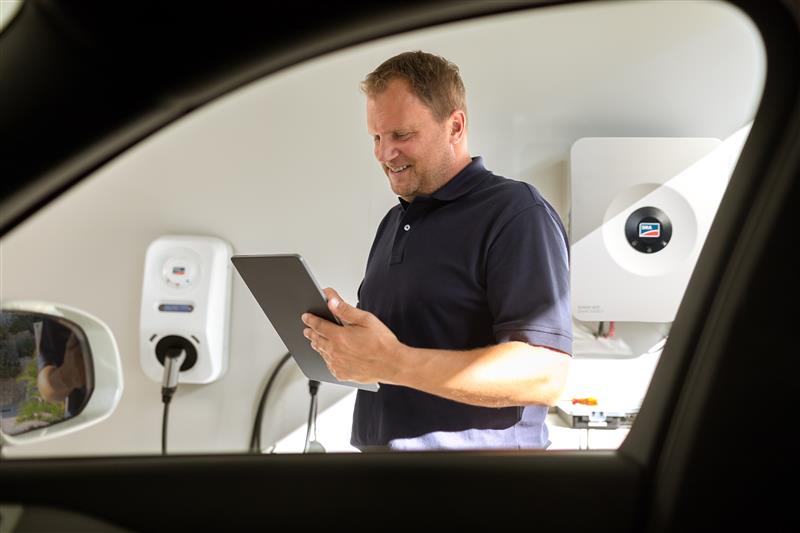
With the SMA eCharger, a new generation of wallboxes for PV-optimized charging has been launched. We have now compiled your questions about the charging solution for electric cars at home. SMA e-mobility expert Lisa Spangenberg answers these frequently asked questions.
Questions on the configuration of charging processes
Can charging processes be set so that the power is drawn from the grid as required and not from the battery?
There is no standard configuration for never charging the SMA eCharger from the home storage system. In the Charging with surplus PV energy mode, the SMA eCharger charges the vehicle with the energy mix set in Sunny Portal (slider). By ticking battery before optional, you decide whether the battery or optional loads are supplied with the surplus PV power first. Depending on the slider setting, energy from the home storage system or the utility grid can also be used to charge the vehicle.
In the Charging with specified target mode, surplus PV energy is initially used for achieving the charging target configured in the SMA Energy App. If there is not enough energy for the charging target, the home storage system is used. Once the home storage system is discharged, energy is drawn from the utility grid.
Information: Smart energy management with the Sunny Home Manager 2.0 optimizes energy flows for the entire house. If a charging target has been configured for the SMA eCharger, the wallbox is considered as necessary load until the charging target is reached. In energy terms, it is therefore irrelevant whether the home storage system is discharged to charge the vehicle or to supply other loads in the house at a later date.
In the Fast charging mode, the vehicle is charged with the maximum power that the vehicle and house allow. Any energy source is used here, so the system could potentially be drawing power from the home storage system to charge your vehicle.
To maintain the self-sufficiency of the house, you have the option of configuring the use range of the home storage system accordingly. The Minimum width of backup power area parameter can be used to reserve a portion of the battery in case of a grid failure. This portion of the battery is reserved for increased self-consumption and is not available for optimizing self-consumption or charging the vehicle.
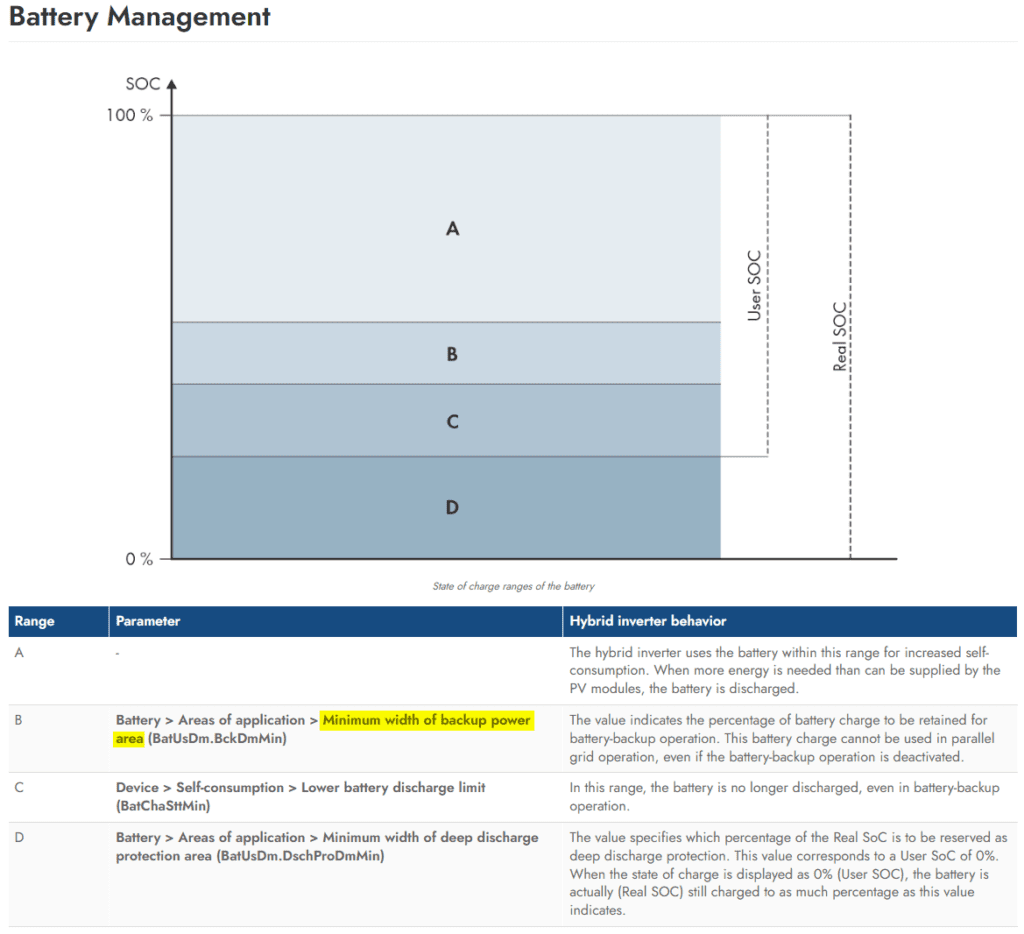
How can I ensure that the SMA eCharger charges primarily from the home storage system without affecting the maximum charging power when there is a surplus PV energy?
There is no standard configuration for charging the SMA eCharger only from the home storage system (see answer above).
In this case, you can limit the maximum charging power of the SMA eCharger under >Device configuration >nominal power WMaxIn to the maximum discharge capacity of the home storage system, for example, 3.5 kW. This ensures that the fully charged home storage system is used first to charge the vehicle. However, this means that the maximum charging power of the SMA eCharger is limited to the configured value, even when charging with surplus PV energy. Alternatively, the charging current can also be limited through the vehicle. This approach allows you to control the maximum charging power.
How can charging processes be evaluated without using the SMA eMobility Portal (export of data directly from the web frontend)?
You can download a list of all events as a .csv file from the device’s user interface under >Monitoring >Event monitor to separately record the charging processes of multiple vehicles on one SMA eCharger. Each time a charging process is initiated using a preprogrammed RFID charging card, Event 9812 logs it along with the assigned card name. At the end of each charging process, Event 9813 records the amount of energy charged by the user in [xx.xxx] kWh. For example, at the end of the month, the amount of energy charged can be allocated to different users.
Example:
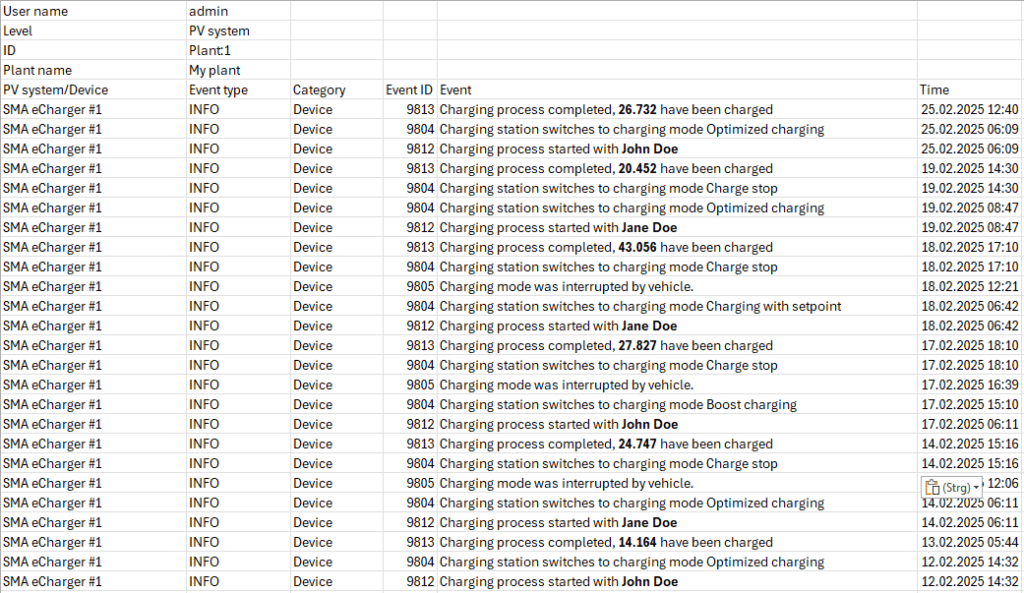
Does the SMA eCharger allow the vehicle to set the charging time?
Yes. To do this, the vehicle must be connected to the SMA eCharger in Fast charging mode. It is charged according to the charging plan stored in the vehicle.
Info: Please note that an active charging plan in the vehicle can cause undesirable behavior in the other two charging modes: Charging with surplus PV energy and Charging with specified target.
How to set surplus charging?
When a vehicle is connected to the SMA eCharger and the charging process is enabled via the SMA Energy App or a preprogrammed RFID charging card, the SMA eCharger defaults to Charging with surplus PV energy mode. Charging of the vehicle starts automatically as soon as sufficient surplus PV power is available. Under Configuration > Device properties > Device control, the minimum PV share can be configured using the slider. Depending on the system configuration, we recommend allowing a low grid supply to prevent frequent charging interruptions.
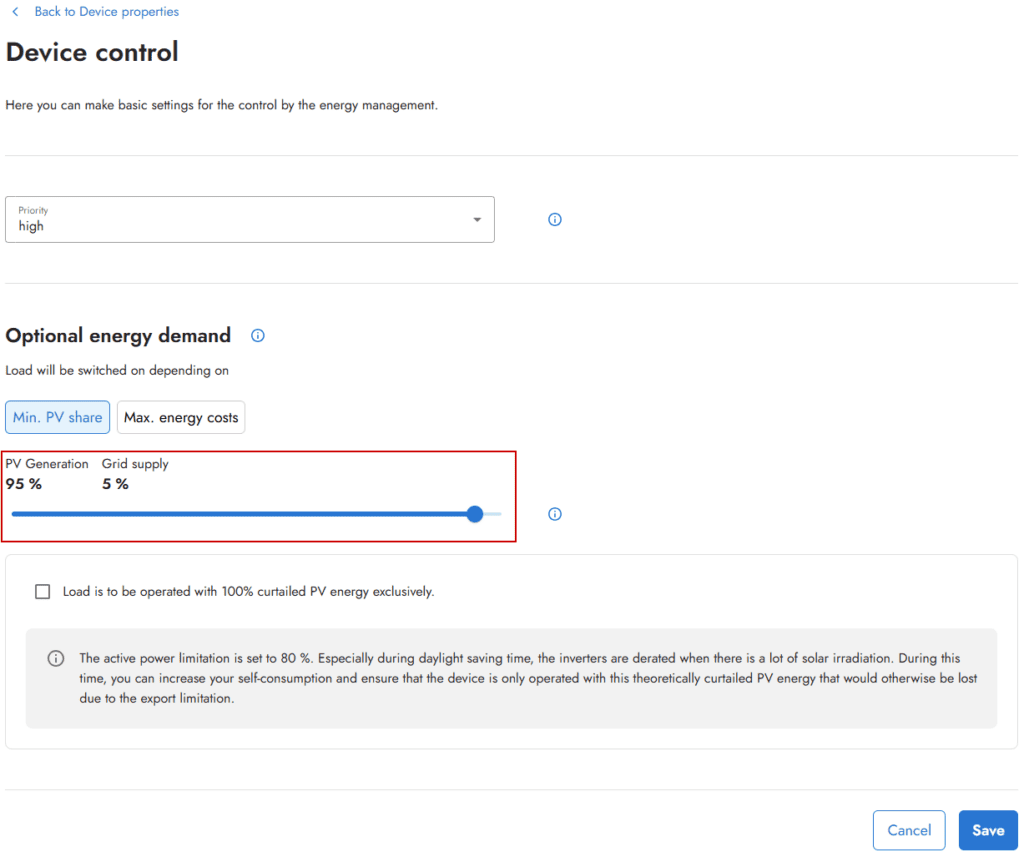
Tip: You can find out how to switch between the different charging modes of the SMA eCharger in this TechTip video. TechTip: How to switch between the charging modes of the SMA eCharger – YouTube
How to make the settings in the Sunny Home Manager 2.0 and Sunny Portal powered by ennexOS in connection with surplus charging?
Tipp: Tip: You can find more information on configuration in Sunny Portal in this blog post: How forecast-based charging works – SMA Blog
The following settings in Sunny Portal powered by ennexOS must be configured correctly to ensure proper functioning of the energy management system and the PV-optimized charging with the SMA eCharger feature:
1. PV system with self-consumption
Configuration > System properties > System data
In self-consumption systems, controllable loads are scheduled in by energy management. This will increase the self-consumption.
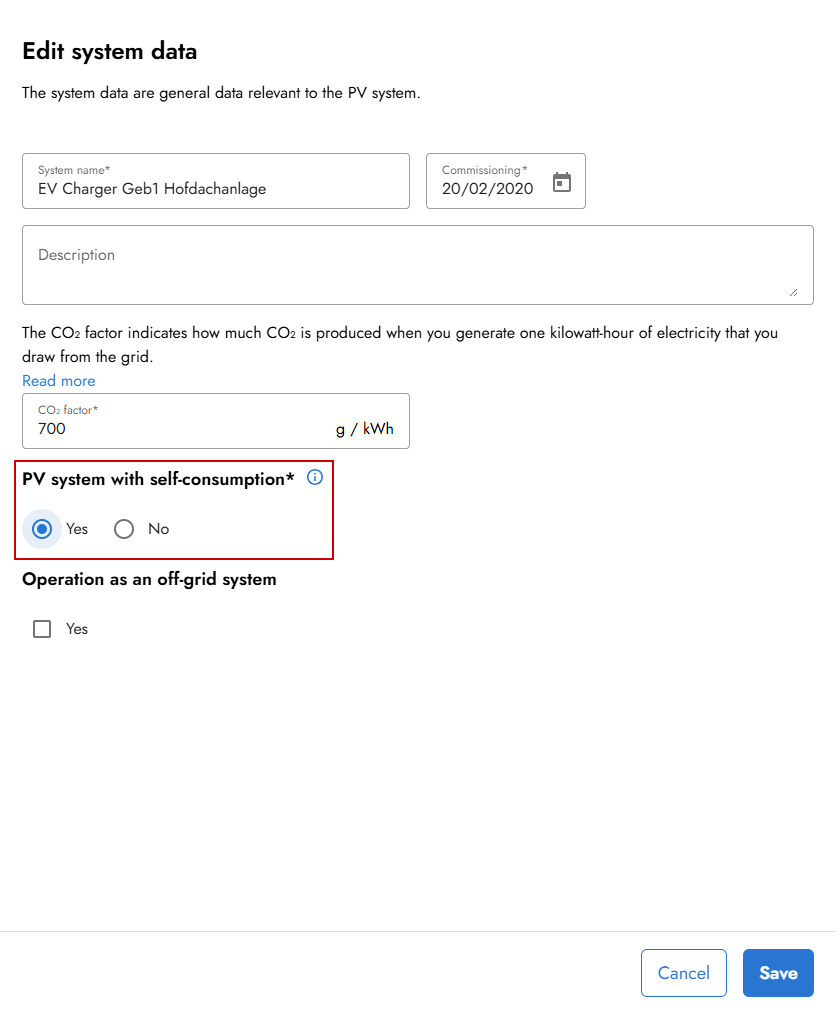
2. Feed-in tariff and electricity tariff
Configuration > System properties > Feed-in tariff and electricity tariff
The entry of the feed-in tariff and electricity tariff valid for the PV system is fundamental to ensure that the Sunny Home Manager 2.0 can correctly plan in accordance with the selected load’s optimization target (ecological/economic). In addition to the fixed tariff, variable electricity prices (e.g. high/low tariffs) can also be configured.
Background: The optimization of the Sunny Home Manager 2.0 takes place exclusively on the basis of pricing tables (even with an ecological optimization target). If the feed-in tariff is not indicated, the corresponding planning cannot take place.
.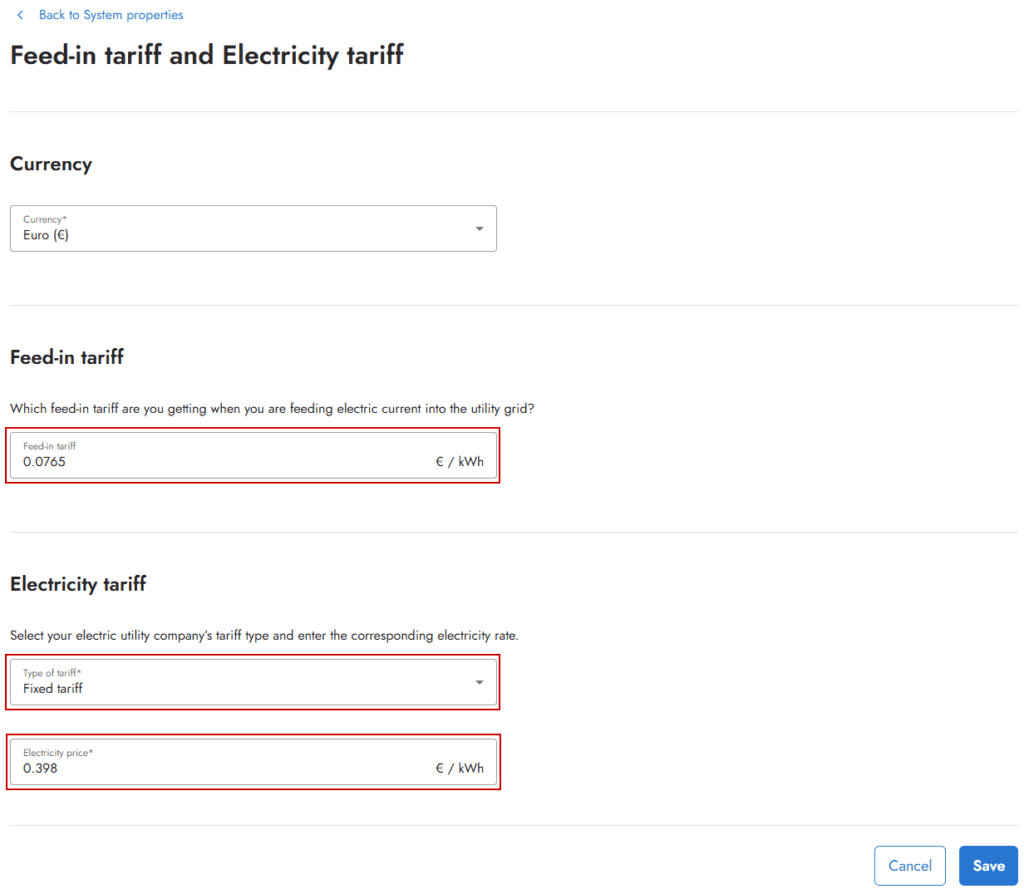
 n
n
3. Location
Configuration > System properties > Location
To calculate the expected PV generation, the exact input of the system location (latitude and longitude) and altitude are required.
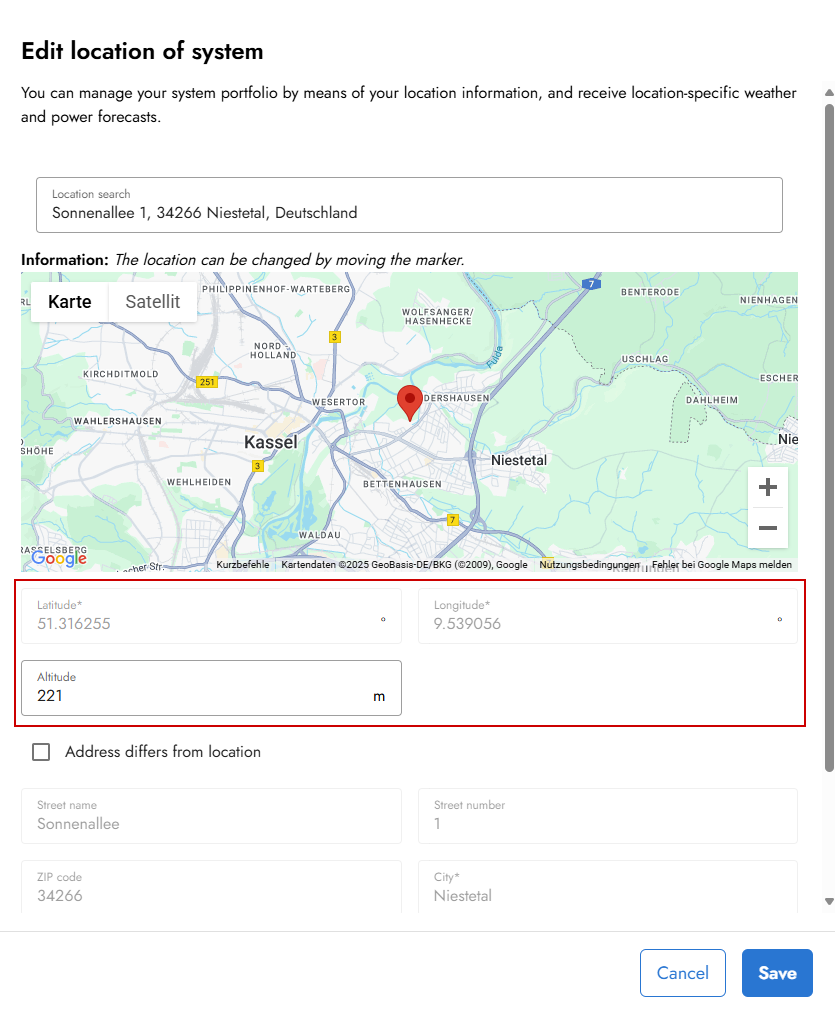
4. String configuration
Configuration > System properties > PV module
Accurate PV forecast calculations (expected PV generation curve) depend heavily on the string configuration, particularly with diverse module orientations. This makes it a key element in planning the load schedules.

5. Battery
Configuration > Energy management > Battery
Ticking Prioritized battery charging ensures the battery is charged first. Only then does the Sunny Home Manager 2.0 consider optional loads like the SMA eCharger in Charging with PV surplus mode.
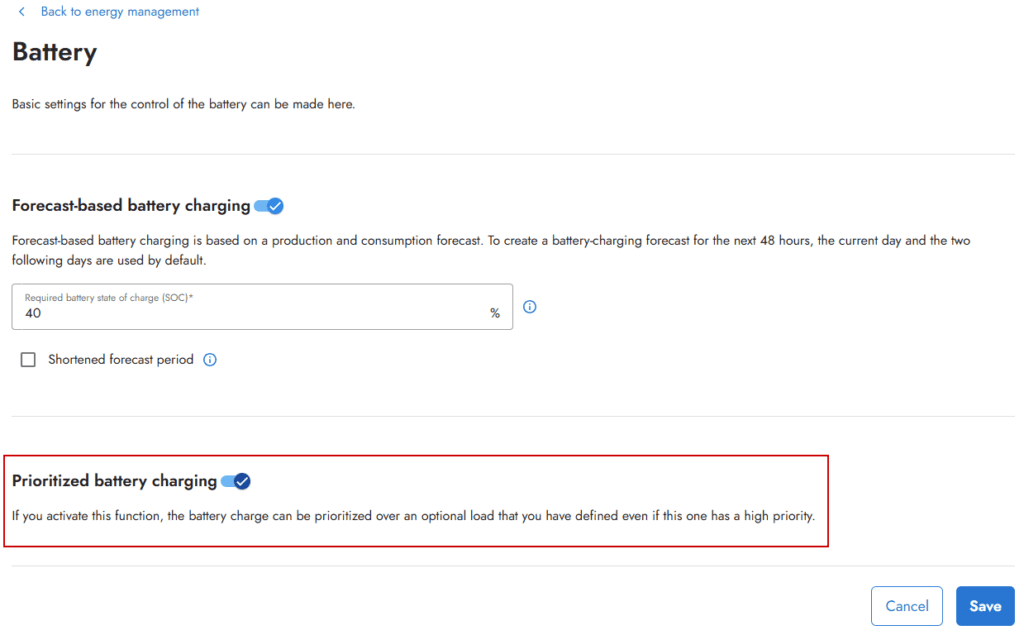
6. Optimization target
Configuration > Energy management > Optimization target
For each system, either an ecological (maximization of PV self-consumption) or an economic (minimization of energy costs) optimization target must be selected. Depending on the situation (e.g. PV feed-in tariff, electricity tariff), the Sunny Home Manager 2.0 planning can vary greatly.
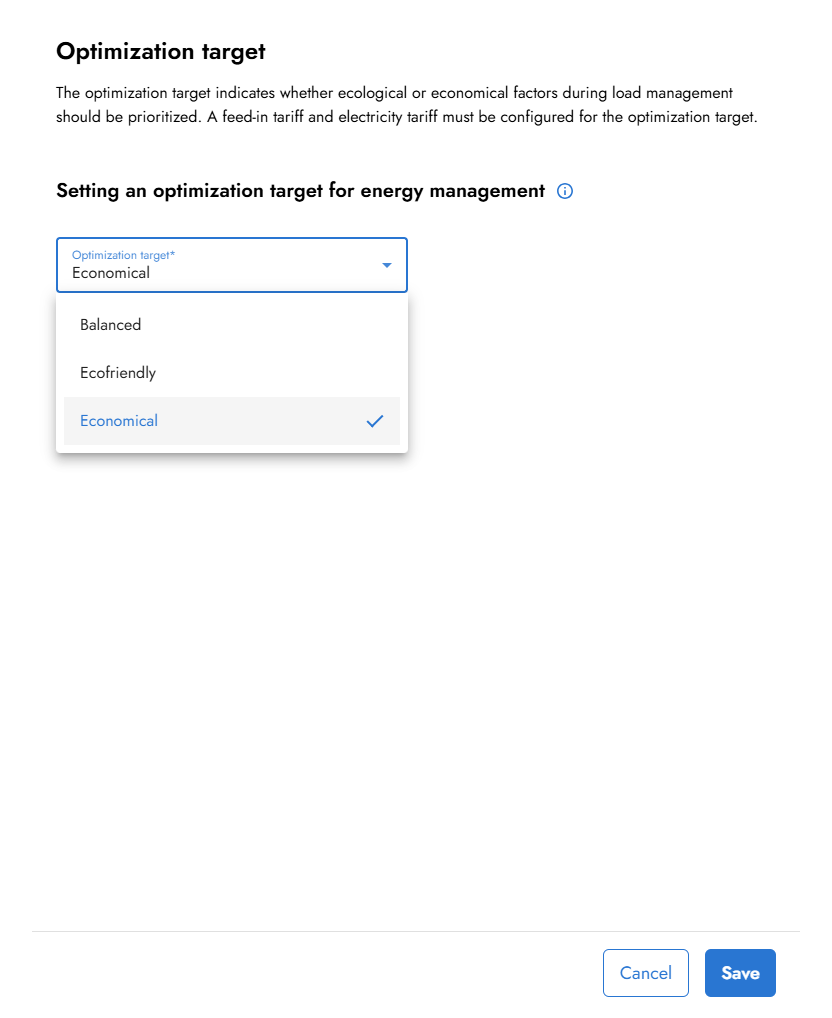
7. Measuring interval
Sunny Home Manager 2.0 > Configuration > Device properties > Extended configuration
The measuring interval determines how frequently the measured values are retrieved from the energy meter at the point of interconnection or the Sunny Home Manager. When the 200 ms measuring interval is selected, the SMA PV and battery or hybrid inverters operate at the maximum possible speed, thereby enhancing control quality and the overall quality of energy management.
Regarding the SMA eCharger, the measuring interval affects the control speed for blackout protection.
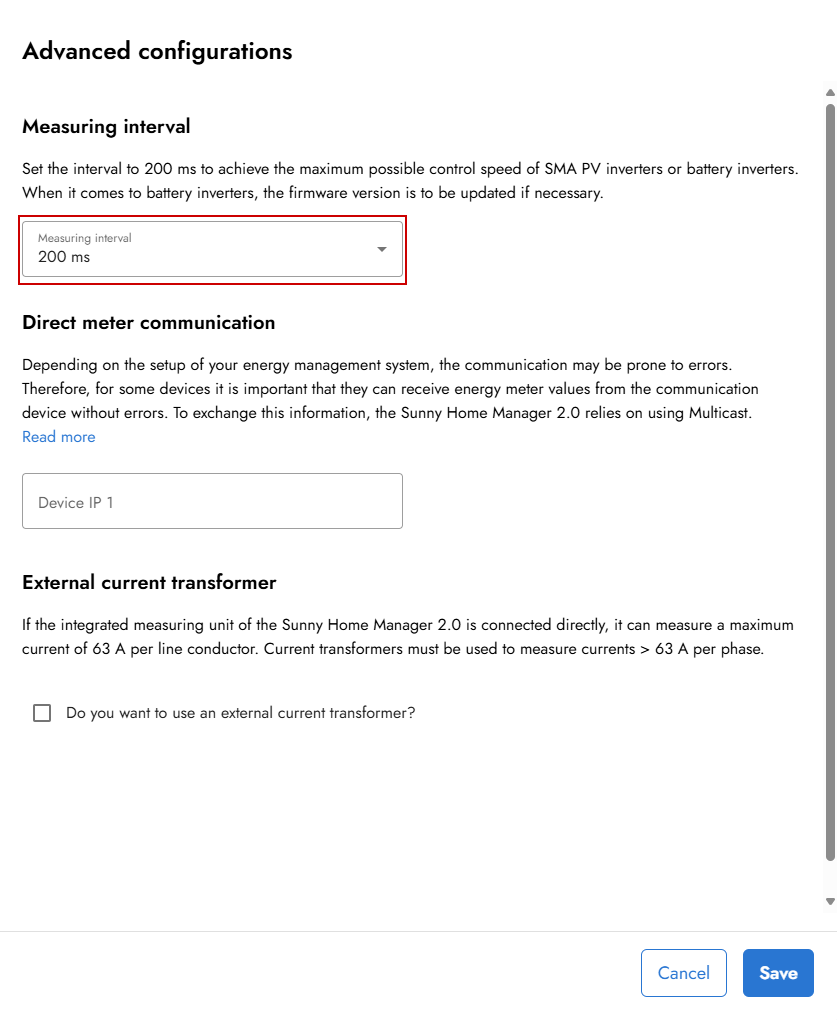
8. Device control
SMA eCharger > Configuration > Device properties > Device control
The priority of the optional load (SMA eCharger in the Charging with surplus PV energy mode) decides in which order the Sunny Home Manager 2.0 considers the individual controllable loads.
Information: Optional loads are devices or applications whose operation is not absolutely necessary (e.g. operating the washing machine). This is in contrast to necessary loads, whose operation is mandatory, even if additional grid-supplied power may be necessary in the event of low solar power supply (e.g. SMA eCharger in the Charging with specified target or Fast charging mode).
The slider is relevant for the planning of optional loads and indicates what minimum share of PV energy is accepted for these appliances. The Sunny Home Manager 2.0 schedules optional loads only if it can ensure that the planning target is met during the course of the day. If the slider is set to 100% PV generation, it is possible that, depending on the size of the system, optional loads cannot be scheduled for use on cloudy days because minimum grid-supplied power cannot be excluded.
Tip: The priority of loads with low power (e.g. washing machine and dishwasher) should be lower than, for example, the priority of the SMA eCharger.
Recommendation: Set to 95% PV generation and 5% grid-supplied power (depending on the PV system size).
Information: If the operation of the load is activated exclusively with 100% curtailed PV energy, then the device will only be operated with the theoretically active power limitation (e.g. to 60%) of curtailed PV energy that would otherwise be lost due to the export limitation.

What settings are recommended to conserve the battery?
It is generally recommended that electric vehicles are not regularly charged above 80 percent SOC (state of charge) to protect the battery. The exact recommendations of the respective manufacturers can be found in the vehicle’s operating manual. Charging limits, such as 80% SOC for AC charging, can usually be configured in the vehicle or through an associated app. The vehicle then stops charging automatically when this limit is reached.
How can I change or reset charging limits, for example, from single-phase to three-phase?
The automatic phase changeover for switching between single-phase and three-phase charging is always active with the SMA eCharger. Configuring the minimum charging current affects the position of the switching limit. With a minimum charging current of 6 A, this is approximately 4.14 kW. If the minimum charging current is increased to 10 A, the switchover limit also shifts upwards to approximately 6.9 kW. If the vehicle is always to be charged in single-phase mode, the SMA eCharger can also be optionally connected and configured as a single-phase wallbox.
Question about the production location / “Made in Germany”
Where is the SMA eCharger manufactured?
The SMA eCharger proudly carries the Made in Germany label. It was engineered and is also produced at the Niestetal site. For more information, please refer to our manufacturer’s declaration:Manufacturer’s declaration – made in Germany
Question about bidirectional charging
When will the bidirectional charging function be available?
The exact timing for this has yet to be determined.
Is the bidirectional charging function subject to costs?
Yes. The feature will be available as an add-on for an additional fee.
Is the SMA eCharger eligible for KfW grant 442 (solar power for electric cars)?
Yes. The SMA eCharger has been on the list of subsidized charging stations for the:KfW subsidy 442 “Solar power for electric vehicles”:
Information: The models currently listed under Bidirectional charging stations are all bidirectional DC wallboxes. We describe the SMA eCharger as AC Bidi-ready. Assuming the hardware for AC bidirectional charging is ready and subject to final standardization, we anticipate being able to offer AC bidirectional charging in combination with AC bidirectional-capable electric vehicles in the future as a paid eProduct. In the course of listing the SMA eCharger with KfW, we proactively approached the funding body to have the SMA eCharger listed as a bidirectional wallbox. Because the relevant standard for AC bidirectional charging is still in the final standardization phase, the National Control Centre for Charging Infrastructure has rejected the listing of the SMA Wallbox.
Customers with a subsidy commitment for a system with a bidirectional wallbox do not need to worry about losing their overall subsidy. The FAQ on the KfW homepage explains that, contrary to the original application, a listed unidirectional wallbox like the SMA eCharger can also be installed. The subsidy entitlement remains valid if the other requirements are met. However, the subsidy amount is reduced by €600, which is the innovation bonus for bidirectional charging.
What does bidirectional charging mean? And what exactly is AC-Bidi?
Bidirectional charging allows electricity to flow from the vehicle back into the house or the utility grid. An inverter is needed to convert the direct current from the vehicle battery into alternating current and synchronize it with the utility grid. Communication between the charging station and the vehicle is facilitated by the ISO 15118-20 communication standard. Depending on the technology used (AC or DC bidirectional), the inverter is either installed in the vehicle or in the charging station.
In bidirectional AC charging, the inverter is located in the vehicle, just as it is with unidirectional AC charging. There are no specific regulations requiring an on-board charger in the vehicle. However, the practical necessity and flexibility as a consumer requirement make it an indispensable component for the time being..
In bidirectional DC charging, the inverter is located in the charging station. The effort and associated costs of mapping the country-specific grid requirements are thus shifting from the vehicle to the stationary charging station. This reduces complexity for vehicle manufacturers but increases development efforts for charging station manufacturers, who currently can only develop products in cooperation with vehicle manufacturers.
Tip: You can find more information about bidirectional charging here [Add link to the article].
Question about conformity with calibration law
Is the new SMA eCharger compliant with calibration regulations?
The SMA eCharger already has an integrated energy meter with an accuracy of +/- 1%. For applications that require an MID-compliant energy meter, this can easily be integrated into the wallbox supply line. SMA is planning a new hardware version of the SMA eCharger with certified MID/calibration law compliance of the wallbox. In addition, there will be a software update for all SMA eChargers that enables integration into the SMA eMobility Portal using the OCPP protocol. These functions lay the foundation for further exciting new use cases with the SMA eCharger and are expected to be available in the coming year. With the SMA EV Charger Business, we already offer an alternative charging solution that enables MID or calibration law-compliant billing of charging processes via the SMA eMobility Portal.
Question about accessories
What additional equipment can I use or do I need?
SMA offers a wide range of accessories for the SMA eCharger. You can find the overview in the datasheet: SMA eCharger – Datasheet
Simply ask your installer or a SMA solar power professional companies for the desired accessories to request a quote. Here are some examples:
5.0|7.5|10.0 m mobile AC charging cable Type 2
(EVC-CBL-3-5-20, EVC-CBL-3-7.5-20, EVC-CBL-3-10-20)
Three-phase AC charging cable in 5.0|7.5|10.0 m lengths as a spare part for the SMA eCharger type EVC22-3AC-20 and SMA EV Charger Business type EVCB-LB-3AC-10 and EVCB-LB-3AC-ECC-10
Charging cable holder
(EVC-CBL-HLD-10)
Charging cable holder for wall mounting of the SMA eCharger
RFID charging cards (10-pack)
(EVC-RFID-10-10)
RFID charging cards as accessories, 10 charging cards for SMA eCharger and SMA EV Charger Business, NXP Mifare Desfire EV3
SMA eCharger charging stand (single-sided)
(EVC-PDSTL-1-20)
Robust charging stand for free-standing, single-sided installation of an SMA eCharger (EVC22-3AC-20), galvanized and powder-coated steel sheet, including cable holder, terminal compartment for integrable distributors, outdoor socket ready for installation and an optional screw fitting with embedded section EVC-GD-PDSTL-10
SMA eCharger charging stand (double-sided)
(EVC-PDSTL-2-20)
Robust charging stand for free-standing, double-sided installation of two SMA eChargers (EVC22-3AC-20), galvanized and powder-coated steel sheet, including cable holder, terminal compartment for integrable distributors, and outdoor socket ready for installation, with an optional screw fitting with embedded section EVC-GD-PDSTL-10
Ground structure for charging stand installation
(EVC-GD-PDSTL-10)
Mounting frame to anchor the charging stand of the SMA eCharger (single-sided/double-sided) into the ground, suitable for use in concrete foundations, compatible with EVC-PDSTL-1-20 and EVC-PDSTL-2-20
Questions about device equipment and features
What degree of protection does the SMA eCharger have? Can it be set up unprotected outdoors?
The SMA eCharger has the degree of protection IP 54 (in accordance with IEC 60529). This means the wallbox is protected against splashing water from all sides and dust. With professional installation, it can be safely placed outdoors.
Will the display language soon be available in German?
At present, the display is only available in English. We are currently evaluating the request for a multilingual display and will update you on the implementation timeline.
Security question
How do I lock the cable to prevent theft?
The charging cable can also be permanently locked to the SMA eCharger through the SMA Energy App, similar to a charging station with a fixed charging cable. To do so, activate the Lock charging cable to charging station parameter during the commissioning of the SMA eCharger under >Device configuration, or at any time via the SMA Energy App. In the E-mobility tab, you can find the option to lock the charging cable under >Settings. When this parameter is activated, only the vehicle’s plug is unlocked once the charging process is complete. The Type 2 charging plug stays connected to the SMA eCharger, ensuring protection against theft.
To remove the charging cable from the SMA eCharger, the parameter can simply be deactivated via the SMA Energy App.
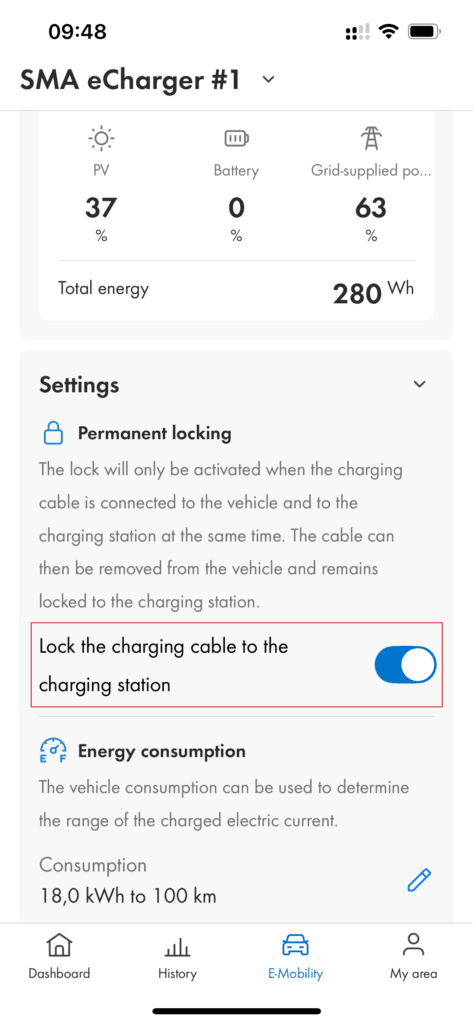
More information can also be found in this TechTip: TechTip: Connecting the charging cable to the SMA eCharger
You can find more information about the SMA eCharger in the FAQ section on the product page:
Charge electric vehicles with solar power: SMA eCharger
For additional support and helpful tips on SMA charging solutions, visit the SMA Online Service Center

Feel free to contribute!